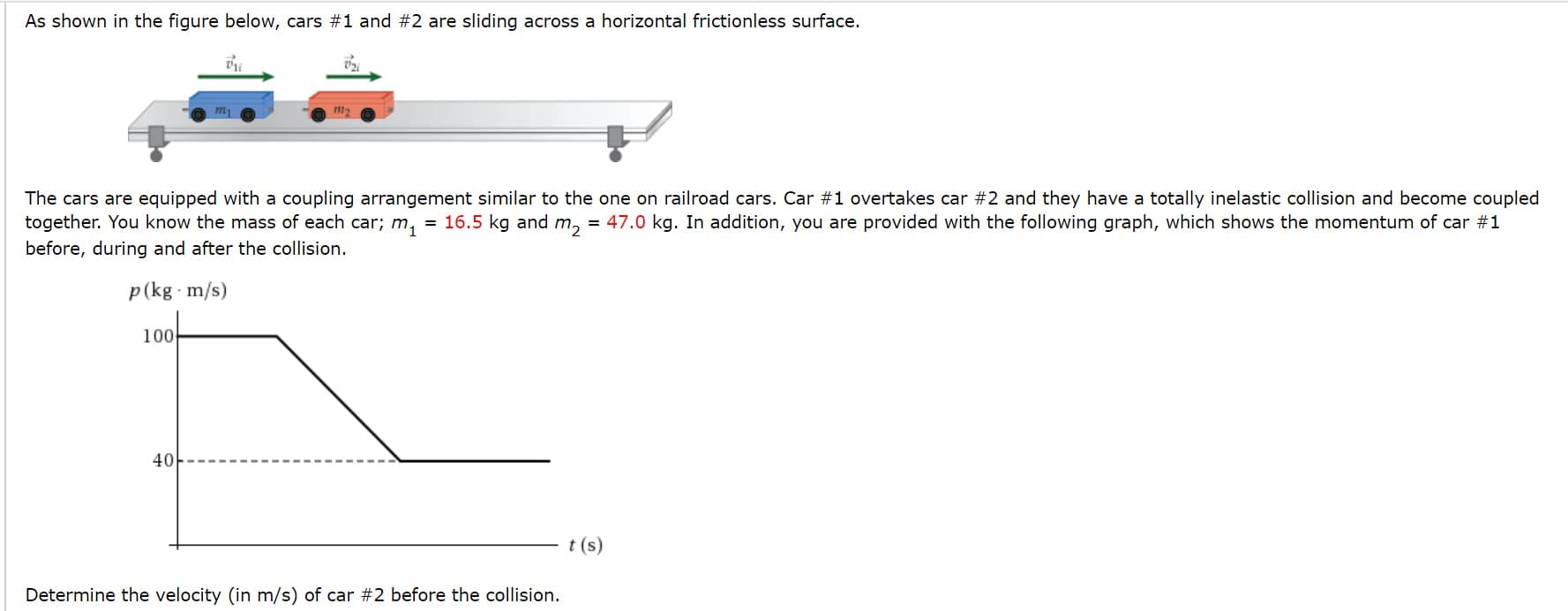As shown in the figure below, cars #1 and #2 are sliding across a horizontal frictionless surface. m2 my The cars are equipped with a coupling arrangement similar to the one on railroad cars. Car #1 overtakes car #2 and they have a totally inelastic collision and become coupled together. You know the mass of each car; m, = 16.5 kg and m, = 47.0 kg. In addition, you are provided with the following graph, which shows the momentum of car #1 before, during and after the collision. p (kg m/s) 100 40 t (s) Determine the velocity (in m/s) of car #2 before the collision.
As shown in the figure below, cars #1 and #2 are sliding across a horizontal frictionless surface. m2 my The cars are equipped with a coupling arrangement similar to the one on railroad cars. Car #1 overtakes car #2 and they have a totally inelastic collision and become coupled together. You know the mass of each car; m, = 16.5 kg and m, = 47.0 kg. In addition, you are provided with the following graph, which shows the momentum of car #1 before, during and after the collision. p (kg m/s) 100 40 t (s) Determine the velocity (in m/s) of car #2 before the collision.
Physics for Scientists and Engineers: Foundations and Connections
1st Edition
ISBN:9781133939146
Author:Katz, Debora M.
Publisher:Katz, Debora M.
Chapter11: Collisions
Section: Chapter Questions
Problem 55PQ: Two bumper cars at the county fair are sliding toward one another (Fig. P11.54). Initially, bumper...
Related questions
Question
conservation of momentum and collision forces problem

Transcribed Image Text:As shown in the figure below, cars #1 and #2 are sliding across a horizontal frictionless surface.
m2
my
The cars are equipped with a coupling arrangement similar to the one on railroad cars. Car #1 overtakes car #2 and they have a totally inelastic collision and become coupled
together. You know the mass of each car; m, = 16.5 kg and m, = 47.0 kg. In addition, you are provided with the following graph, which shows the momentum of car #1
before, during and after the collision.
p (kg m/s)
100
40
t (s)
Determine the velocity (in m/s) of car #2 before the collision.
Expert Solution
This question has been solved!
Explore an expertly crafted, step-by-step solution for a thorough understanding of key concepts.
This is a popular solution!
Trending now
This is a popular solution!
Step by step
Solved in 3 steps with 2 images

Knowledge Booster
Learn more about
Need a deep-dive on the concept behind this application? Look no further. Learn more about this topic, physics and related others by exploring similar questions and additional content below.Recommended textbooks for you

Physics for Scientists and Engineers: Foundations…
Physics
ISBN:
9781133939146
Author:
Katz, Debora M.
Publisher:
Cengage Learning

Principles of Physics: A Calculus-Based Text
Physics
ISBN:
9781133104261
Author:
Raymond A. Serway, John W. Jewett
Publisher:
Cengage Learning

University Physics Volume 1
Physics
ISBN:
9781938168277
Author:
William Moebs, Samuel J. Ling, Jeff Sanny
Publisher:
OpenStax - Rice University

Physics for Scientists and Engineers: Foundations…
Physics
ISBN:
9781133939146
Author:
Katz, Debora M.
Publisher:
Cengage Learning

Principles of Physics: A Calculus-Based Text
Physics
ISBN:
9781133104261
Author:
Raymond A. Serway, John W. Jewett
Publisher:
Cengage Learning

University Physics Volume 1
Physics
ISBN:
9781938168277
Author:
William Moebs, Samuel J. Ling, Jeff Sanny
Publisher:
OpenStax - Rice University

Physics for Scientists and Engineers, Technology …
Physics
ISBN:
9781305116399
Author:
Raymond A. Serway, John W. Jewett
Publisher:
Cengage Learning

Classical Dynamics of Particles and Systems
Physics
ISBN:
9780534408961
Author:
Stephen T. Thornton, Jerry B. Marion
Publisher:
Cengage Learning

College Physics
Physics
ISBN:
9781305952300
Author:
Raymond A. Serway, Chris Vuille
Publisher:
Cengage Learning